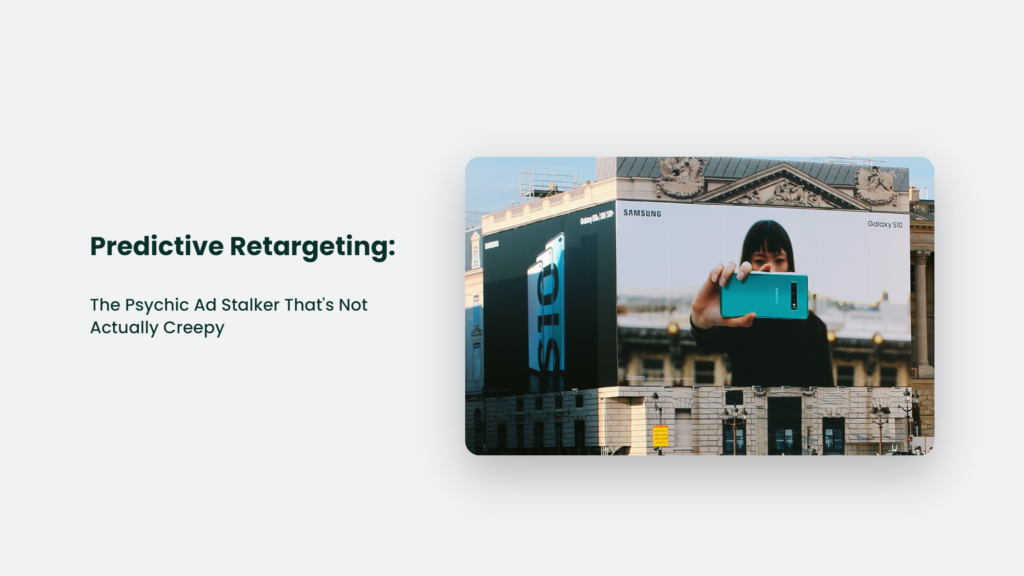Imagine this: You’re browsing through your favourite online store for funky socks, but your cheap ass decides not to buy them (yet). The next day, you’re surfing the web and bam!
Welcome to the magical world of retargeting, my friend! There they are again, those incredibly stylish socks begging you to click “buy now” and get them delivered to your doorstep. But wait, it gets even better.

A Tale of Socks and Retargeting
Retargeting is like that friend who knows you a little too well. They know when you need a pep talk, a coffee, or some ridiculously awesome socks. You might wonder how they do it, but you’re not complaining. The secret sauce is predictive retargeting, the psychic version of your ad stalker.
Now, let’s take a trip down memory lane.
Remember when you were craving pizza, and suddenly, an ad for your local pizzeria popped up? Coincidence? I think not. It’s predictive retargeting in action, and it’s like having a personal marketing fairy godmother following you around. But how does this sorcery work? Let’s dive in.
The Crystal Ball of Advertising: Predictive Analytics
Predictive retargeting is like Sherlock Holmes meets advertising. It’s not content with just following you around, showing you ads for things you’ve already looked at. Oh no, it wants to predict what you’ll want next. It’s like the sorting hat from Harry Potter, but for your consumer desires.
This method uses data (tons of it) and machine learning algorithms to analyze your browsing behaviour, predict your interest, and serve up ads that’ll make you go, “Oh, yeah, I do want that!” Here’s how the magic happens:
- Collecting data: The first step is to gather data about you. Don’t worry; it’s not as creepy as it sounds. They’re just tracking your online activity, like the websites you visit, the things you search for, and your social media behaviour. Just think of it as your friendly neighbourhood algorithm, watching over you like a guardian angel.
- Analyzing the data: Once they’ve got their hands on your data, they’ll start looking for patterns. Like, are you a cat person or a dog person? Do you prefer tacos or burritos? Do you have an unhealthy obsession with socks? The algorithm will get to know you better than your mother.
- Making predictions: Now that the algorithm has a pretty good idea of who you are and what you like, it’s time to make educated guesses about what you might want. It’s like that game where you must guess what’s in the box, but with a much higher success rate.
- Serving up ads: Finally, the algorithm will show ads based on its predictions. You might see an ad for dog food if it thinks you’re a dog person or an ad for the latest sock fashion if it knows about your sock obsession. It’s like a personalized shopping assistant but less annoying.
The Proof is in the Pudding: Why Predictive Retargeting Works
You might think, “Sure, that all sounds cool, but does it work?” Well, dear reader, let me hit you with some hard facts.
According to a study by eMarketer, retargeted ads have a 10x higher click-through rate than regular display ads. And when it comes to predictive retargeting, things get even more impressive.
A report from B2C Marketing Insider found that predictive retargeting can boost conversion rates by up to 30%. That’s like going from a casual sock enthusiast to a full-blown sock connoisseur.
But why is it so effective? The answer lies in the power of relevance. We live in an age of information overload, and our brains are wired to filter out anything that doesn’t seem important.
Predictive retargeting cuts through the noise by showing us ads that we actually care about. It’s like a friend who knows exactly what you want to discuss at a party.
The Good, the Bad, and the Ugly: Pros and Cons of Predictive Retargeting
Now that you’ve seen the light, let’s weigh the pros and cons of predictive retargeting. Because, let’s face it, nothing in life is perfect (except maybe those funky socks you’ve been eyeing).
Pros:
- Higher engagement: People are more likely to click on ads that are relevant to them. It’s like the difference between seeing an ad for socks when you’re a sock fanatic and seeing an ad for socks when you couldn’t care less about socks.
- Better ROI: With higher engagement comes better ROI. Businesses can get more bang for their buck by investing in predictive retargeting, making it a win-win situation for both marketers and consumers.
- Improved customer experience: Predictive retargeting is like having a personal shopper who knows exactly what you want. It makes the online shopping experience more enjoyable and efficient, which can lead to increased brand loyalty.
Cons:
- Privacy concerns: Some people might find the idea of an algorithm tracking their every move a little…unsettling. However, it’s important to remember that the data used in predictive retargeting is anonymized and aggregated, meaning it can’t be traced back to you personally.
- Ad fatigue: Even the most relevant ads can become annoying if you see them too often. Predictive retargeting algorithms need to strike the right balance between persistence and overkill.
So, What’s the Verdict?
Is predictive retargeting the future of advertising, or is it just another marketing fad? Well, I’m no fortune-teller, but I’d say it’s here to stay. The benefits far outweigh the drawbacks, and as long as businesses continue to see results, they’ll keep investing in it.
Frequently Asked Questions:
How can I control the ads I see through predictive retargeting?
Most browsers and social media platforms allow you to adjust your ad preferences, so you can have some say in the types of ads you see.
Is predictive retargeting only for online shopping?
No! Predictive retargeting can be used for all kinds of advertising, including content marketing and lead generation.
Can I opt-out of predictive retargeting?
Yes, you can usually opt-out of targeted advertising through your browser or device settings. However, keep in mind that you’ll still see ads – they just won’t be personalized to your interests.
The Bottom Line:
To sum it up, predictive retargeting is like the cool older sibling of regular retargeting. It’s smarter, more efficient, and more in tune with your needs. It might feel a little spooky at first, but once you get used to it, you’ll wonder how you ever lived without it. So sit back, relax, and let the psychic ad stalker do its thing. You might just discover your next favourite pair of funky socks.
Now, go forth and embrace the world of predictive retargeting! And remember, whether you’re a cat person, a dog person, or a sock fanatic, there’s an ad out there just waiting to be clicked by you.




